An Illustrated Pocketbook of Parkinson''''s Disease and Related Disorders pot
Bạn đang xem bản rút gọn của tài liệu. Xem và tải ngay bản đầy đủ của tài liệu tại đây (3.85 MB, 81 trang )
An Illustrated Pocketbook of MRI. Disease and Related Disorders
An Illustrated Pocketbook of
Parkinson's Disease and Related
Disorders
G.David Perkin, BA, FRCP
Regional Neurosciences Centre,
Charing Cross Hospital, London, UK
The Parthenon Publishing Group
International Publishers in Medicine, Science & Technology
A CRC PRESS COMPANY
BOCA RATON LONDON NEW YORK WASHINGTON, D.C.
Published in the USA by
The Parthenon Publishing Group
345 Park Avenue South, 10th Floor
New York, NY 10010, USA
This edition published in the Taylor & Francis e-Library, 2005.
“To purchase your own copy of this or any of Taylor & Francis or Routledge’s collection of thousands of eBooks please go to
www.eBookstore.tandf.co.uk.”
Published in the UK and Europe by
The Parthenon Publishing Group Limited
23–25 Blades Court
Deodar Road
London SW15 2NU, UK
Library of Congress Cataloging-in-Publication Data
Data available on application
British Library Cataloguing in Publication Data
Data available on application
ISBN 0-203-48748-6 Master e-book ISBN
ISBN 0-203-59621-8 (Adobe eReader Format)
ISBN 1-84214-142-2 (Print Edition)
Copyright © 2003 The Parthenon Publishing Group
No part of this book may be reproduced in any form without
permission from the publishers except for the quotation of brief
passages for the purposes of review
Composition by The Parthenon Publishing Group
Contents
Anatomy
1
Parkinson’s disease
3
Neuropathology
3
Epidemiology
4
Clinical features
4
Imaging
6
Drug intervention
7
Parkinsonian syndromes
18
Postencephalitic parkinsonism
18
Drug-induced parkinsonism
18
Arteriosclerotic parkinsonism
19
Cortical Lewy body disease
20
Related disorders
26
Progressive supranuclear palsy (Steele-Richardson-Olszewski syndrome)
26
Striatonigral degeneration
27
Multiple system atrophy
29
Imaging
33
Corticobasal degeneration
35
Dystonia
36
Wilson’s disease
44
Huntington’s disease
48
Hallervorden-Spatz disease
51
Sydenham’s chorea
51
Tremor
52
Myoclonus
54
v
Tardive dyskinesia and dystonia
55
Selected bibliography
69
Index
73
Anatomy
The neurons of the corpus striatum receive an excitatory input from the cerebral cortex and the thalamus.
The major outputs project to the globus pallidus and the substantia nigra pars reticula (SNr), and use
gamma-aminobutyric acid (GABA) as a transmitter. Major efferent pathways from the globus pallidus
interna and the SNr project to the thalamus. Feedback to the striatum is through the dopaminergic
striatonigral pathway originating in the substantia nigra pars compacta (SNc; Figure 1).
These separate pathways utilize different neuropeptides and dopamine receptors. The direct pathway from
the striatum to the globus pallidus interna (GPi) and SNr expresses substance P and dynorphin, and uses D1
dopamine receptors. The neurons projecting from the striatum to the external segment of the globus pallidus
(GPe) express enkephalin and use D2 receptors. (Some neurons express both receptors.)
Figure 1 Major pathways of the basal ganglia. Modified from Riley DE, Lang AE. In Bradley WG, et al., Neurology in
Clinical Practice. London: Butterworth Heinemann, 1996
Depletion of dopamine in the striatum results in increased activity of the striatopallidal pathway and
decreased activity in the direct pathway. These effects (the former leading to disinhibition of the
subthalamic nucleus) lead to increased activity of the GABAergic neurons of the output nuclei of the basal
ganglia. Increased inhibitory output from these nuclei may be responsible for the bradykinesia seen in
patients with Parkinson’s disease (Figure 2).
2
AN ILLUSTRATED POCKETBOOK OF PARKINSON’S DISEASE
Figure 2 Connections of striatal output neurons. Modified from Goetz CG, De Long MR, Penn RD, Bakay RA.
Neurosurgical horizons in Parkinson’s disease. Neurology 1993;43:l–7
Parkinson's disease
Any discussion of the clinical characteristics of Parkinson’s disease must take into account the inaccuracies
of clinical diagnosis. In a successive series of 100 patients with a clinical diagnosis of Parkinson’s disease,
only 76 fulfilled the criteria for diagnosis at postmortem examination (Table 1). Attempts to tighten the
diagnostic criteria lead to increased specificity but reduced sensitivity.
Neuropathology
Typically, there is loss of at least 50% of the melanin-containing nerve cells of the substantia nigra, the
changes being concentrated in the central part of the zona compacta (Figure 3). Accompanying these
changes is depletion of tyrosine hydroxylase, the rate-limiting enzyme in the biosynthetic pathway for
catecholamines (Figures 4 and 5). A characteristic, indeed inevitable, finding is the presence of Lewy
bodies in some of the remaining nerve cells (Figure 6).
Table 1 Pathological findings in 100 successive Parkinsonian patients
Idiopathic Parkinson’s disease
Progressive supranuclear palsy
Multiple system atrophy
Alzheimer’s disease
Alzheimer-type pathology with striatal involvement
Lacunar state
Nigral atrophy
Postencephalitic parkinsonism
Normal (?essential tremor)
76
6
5
3
3
3
2
1
1
Together with Lewy body formation, degenerative changes occur at other sites, including the locus
ceruleus, the dorsal motor nucleus of the vagus, the hypothalamus, the nucleus basalis of Meynert and the
sympathetic ganglia. Cortical Lewy bodies are probably present in all patients with idiopathic Parkinson’s
disease, although not with the frequency that would permit a diagnosis of cortical Lewy body disease (vide
infra).
In parkinsonian patients with cortical dementia, the pathological changes are either those of cortical Lewy
body disease, or those associated with Alzheimer’s disease, including senile plaques, neurofibrillary
tangles, granulovacuolar degeneration, and nerve cell loss in the neocortex and hippocampus.
4
AN ILLUSTRATED POCKETBOOK OF PARKINSON’S DISEASE
Figure 3 Parkinson’s disease: horizontal sections of midbrain (upper) and pons (lower). Courtesy of S.E.Daniel, The
Parkinson’s Disease Society Brain Research Centre, Institute of Neurology, London, UK
Epidemiology
The prevalence of Parkinson’s disease has been reported to lie between 30 and 300 per 100 000, producing
approximately 60 to 80 000 cases in the United Kingdom. Prevalence increases with age and the disease is
slightly more common in men (Figure 7). Cigarette smoking provides some protective effect, whereas the
risk is possibly increased in those with a history of herbicide or metal exposure. A family history of
Parkinson’s disease is associated with an increased disease risk. Both autosomal-dominant and autosomalrecessive forms of the disease are recognized.
Clinical features
Typically, the condition produces bradykinesia, tremor, rigidity, and impairment of postural reflexes. An
asymmetrical onset is characteristic.
Bradykinesia
Paucity of movement can affect any activity and is best measured by assessing aspects of daily living. The
problem tends to involve one upper limb initially, leading to difficulty with fine tasks, such as manipulating
AN ILLUSTRATED POCKETBOOK OF PARKINSON’S DISEASE
5
Figure 4 Parkinson’s disease: control section of normal substantia nigra (immunostained for tyrosine hydroxylase).
Courtesy of S.E.Daniel, The Parkinson’s Disease Society Brain Research Centre, Institute of Neurology, London, UK
a knife or fork, dressing or shaving. The patient’s handwriting typically becomes reduced in size if the
dominant hand is affected (Figure 8). Associates are likely to comment on a reduction of arm swing when
walking. Facial immobility is evident, with a lack of animation and immediate emotional response
(Figure 9). The posture is stooped, and becomes more so as the condition progresses (Figures 10 and 11).
Walking becomes slowed, with a tendency to reduce stride length and an increased number of steps being
taken when turning. The problem can be assessed by asking the patient to repetitively tap with the hand or
foot, or to mimic a polishing motion with the hand, or to rhythmically clench and unclench the fingers
(Figure 12). Even if the amplitude of such movements is initially retained, it soon diminishes and may even
cease.
Rigidity
The rigidity associated with Parkinson’s disease is also often asymmetrical at onset. It tends to be diffusely
distributed throughout the limb although, initially, it may be more confined. It persists throughout the range
of motion of any affected joint. A characteristic judder (cogwheeling) occurs at a frequency similar to that of
the postural tremor seen in Parkinson’s disease rather than at the rate of the resting tremor. If the rigidity is
equivocal, it can be activated by contracting the contralateral limb.
Tremor
The classical parkinsonian tremor occurs at rest, at a frequency of around 3–4 Hz (Figure 13). It is present
in over 70% of cases at diagnosis. The tremor briefly inhibits during a skilled activity. A faster, postural
tremor of around 6–8 Hz is sometimes evident, initially at a time when the rest tremor is absent. The rest
6
AN ILLUSTRATED POCKETBOOK OF PARKINSON’S DISEASE
Figure 5 Parkinson’s disease: substantia nigra showing depletion of tyrosine hydroxylase (immunostained for tyrosine
hydroxylase). Courtesy of S.E.Daniel, The Parkinson’s Disease Society Brain Research Centre, Institute of Neurology,
London, UK
tremor most commonly involves the upper limb, producing either flexion/extension movements or
pronation/supination, or a combination of these.
Postural reflexes
In addition to abnormalities of posture, the patient has difficulty maintaining posture when suddenly pushed
forwards or backwards. Other features of Parkinson’s disease include dementia (perhaps in around 15–20%
of patients), autonomic dysfunction (principally in the form of urinary urgency and occasional
incontinence) and a variety of eye signs, including broken pursuit movements, and some limitation of
upward gaze and convergence. A positive glabellar tap (producing repetitive blinking during tapping over
the glabella) occurs in the majority, but is also seen in Alzheimer’s disease.
Imaging
Although imaging techniques, particularly positron emission tomography (PET) scanning, are not relevant
to the diagnosis of most patients with Parkinson’s disease, they do provide insight into the pathophysiology
of the disease and can assume clinical relevance where clinical presentation is atypical. PET scans using 6–
[18F]-fluorodopa show reduced uptake of the isotope, particularly in the putamen, and mainly contralateral
to the clinically more affected side (Figure 14).
AN ILLUSTRATED POCKETBOOK OF PARKINSON’S DISEASE
7
Figure 6 Parkinson’s disease: microscopic views of a Lewy body stained by H & E (left) and by modified
Bielschowsky stain (right). Courtesy of W.R.G.Gibb, Institute of Psychiatry, London, UK
Figure 7 Parkinson’s disease: graph showing age and gender distribution at the time of diagnosis
Drug intervention
There are potentially several stages during the synthesis, release and metabolism of dopamine within the
central nervous system at which intervention, by enhancing dopamine levels, may influence the clinical
manifestations of Parkinson’s disease.
Dopa is converted to dopamine within the dopaminergic neuron by the action of L-aromatic amino acid
decarboxylase (dopa decarboxylase). The dopamine is then transported into storage vesicles before being
released, through depolarization and entry of calcium ions, to act on the postsynaptic dopamine receptor site.
8
AN ILLUSTRATED POCKETBOOK OF PARKINSON’S DISEASE
Figure 8 Parkinson’s disease: micrographia
Figure 9 Parkinson’s disease: facial appearance
Some of the dopamine is taken up again in the dopaminergic neuron, while another part is converted within
glial cells to 3-methoxytyramine, by the action of catechol O-methyltransferase (COMT). The 3methoxytyramine is then metabolized by monoamine oxidase-B to homovanillic acid (HVA). Some of the
dopamine that is taken up again into the neuron is transported back into storage vesicles, whereas the
remainder is metabolized by monoamine oxidase-B to 3,4-dihydrophenylacetic acid (DOPAC).
Dopaminergic activity can therefore be enhanced by providing more precursor (dopa; Figure 15),
stimulating dopamine release (amantadine), using an agonist to act on the dopamine receptor site
(bromocriptine, pramipexole, lysuride, pergolide, ropinirole or cabergoline), or inhibiting dopamine
breakdown through inhibition of either monoamine oxidase (selegiline) or of COMT (tolcapone,
entacapone). Tolcapone is no longer licensed in the United Kingdom.
Dopa, combined with dopa decarboxylase inhibitor, remains the cornerstone of treatment. The use of
subcutaneous apomorphine as a diagnostic test for idiopathic Parkinson’s disease has been advocated, but
both false-positive and false-negative results occur. There is no consensus as to whether agonist therapy
should be introduced earlier or later. After 5–10 years, major therapeutic problems arise, with loss of
efficacy, fluctuations in response, and the emergence of increasingly uncontrollable dyskinesias or dystonic
AN ILLUSTRATED POCKETBOOK OF PARKINSON’S DISEASE
9
Figure 10 Posture in early Parkinson’s disease
posturing (Figures 16 and 17). These problems have stimulated consideration of other therapeutic
approaches, including thalamic and pallidal surgery, and transplantation of dopaminergic grafts. Such
grafts, derived from human embryonic mesencephalic tissue, have been shown to have a functional effect
for at least 3 years after transplantation, as substantiated by evidence of enhanced putaminal fluorodopa
uptake over the same period (Figure 18).
10
AN ILLUSTRATED POCKETBOOK OF PARKINSON’S DISEASE
Figure 11 Posture in later-stage Parkinson’s disease
AN ILLUSTRATED POCKETBOOK OF PARKINSON’S DISEASE
Figure 12 Parkinson’s disease: impaired fist clenching
11
12
AN ILLUSTRATED POCKETBOOK OF PARKINSON’S DISEASE
Figure 13 Parkinson’s disease: tremor illustrated as a power spectrum (upper) and accelerometer tracing (lower).
Courtesy of P.Bain, The West London Neurosciences Centre, Charing Cross Hospital, London, UK
AN ILLUSTRATED POCKETBOOK OF PARKINSON’S DISEASE
Figure 14 Parkinson’s disease: 6-[18F]fluorodopa PET scans of control (upper) vs. patient (lower)
13
14
AN ILLUSTRATED POCKETBOOK OF PARKINSON’S DISEASE
Figure 15 Parkinson’s disease: synthesis and metabolism of dopamine within the central nervous system, and sites at
which dopaminergic activity may be enhanced
AN ILLUSTRATED POCKETBOOK OF PARKINSON’S DISEASE
Figure 16 Parkinson’s disease: dystonic posturing of the big toe secondary to dopa therapy
15
16
AN ILLUSTRATED POCKETBOOK OF PARKINSON’S DISEASE
Figure 17 Parkinson’s disease: dystonic posturing of the right thumb and little finger secondary to dopa therapy
AN ILLUSTRATED POCKETBOOK OF PARKINSON’S DISEASE
17
Figure 18 Fluorodopa uptake studies following dopaminergic grafting. Reproduced with permission from LippincottRaven, Lindvall O, Sawle G, Widner H, et al. Evidence for long-term survival and function of dopaminergic grafts in
progressive Parkinson’s disease. Ann Neurol 1994;35:172–80
Parkinsonian syndromes
A vast number of disorders can produce a clinical picture that closely resembles Parkinson’s disease
(Table 2).
Postencephalitic parkinsonism
Cases of postencephalitic parkinsonism still occur sporadically. Besides the parkinsonism, clinical features
include oculogyric crises, behavioral disorders, pyramidal tract signs and various movement abnormalities.
Depigmentation of the substantia nigra is evident, along with the presence of neurofibrillary tangles.
Although inflammatory cells are conspicuous in the acute stage, they may still be present years later.
Table 2 Disorders with clinical presentations similar to Parkinson’s disease
Symptomatic parkinsonism
Postencephalitic
Drug-induced
Toxic
Traumatic
Arteriosclerotic
Normal pressure hydrocephalus
Striatonigral degeneration
Parkinsonism in other degenerative disorders
Multiple system atrophy
Progressive supranuclear palsy
Corticobasal degeneration
Diffuse Lewy body disease
Drug-induced parkinsonism
Any drug affecting the synthesis, storage or release of dopamine, or interfering with dopamine receptor
sites, is capable of causing an akinetic rigid syndrome that may closely resemble idiopathic Parkinson’s
disease. The most well-recognized drugs in this category are the phenothiazines but, in addition, a calcium-
AN ILLUSTRATED POCKETBOOK OF PARKINSON’S DISEASE
19
Figure 19 Binswanger’s encephalopathy: coronal section of brain showing abnormal white matter. Courtesy of
D.Miller, NYU Medical Center, New York, and M.H.Mark, The University of Medicine and Dentistry of New Jersey,
NJ, USA
blocking vasodilator such as flunarizine or the antihistamine cinnarizine can induce parkinsonism, possibly
through a presynaptic effect on dopaminergic and serotonergic neurons.
The condition tends to be symmetrical and to lack tremor. If a tremor is present, it tends to be postural
and of a higher frequency than the classical resting tremor of idiopathic Parkinson’s disease. Most cases are
evident within 3 months of starting therapy.
The problem is more likely to affect the elderly and women, and may take several months to subside after
drug withdrawal If the symptoms are disabling and the drug therapy is still required, either amantadine or an
anticholinergic agent has been suggested as appropriate treatment.
Arteriosclerotic parkinsonism
Parkinsonian features are sometimes part of the clinical spectrum associated with diffuse cerebrovascular
disease. In the original description, certain clinical features were held to distinguish arteriosclerotic
parkinsonism from idiopathic Parkinson’s disease, including the lack of tremor, a predominance of gait
involvement over upper limb disorder and the presence of signs in other systems, for example, bilateral
extensor plantar responses. In such patients, particularly those with a history of hypertension or stroke-like
events, the possibility of a Binswanger-type encephalopathy as the underlying mechanism is considerable
(Figure 19).
Microscopy reveals sharply defined zones of myelin loss (Figure 20), with or without coexistent areas of
lacunar infarction (Figure 21).
Either pathology is usually demonstrable with appropriate imaging (Figure 22).
Some patients with a parkinsonian state due to vascular disease have rest tremor, whereas others show
dopa responsiveness. Whether expanded perivascular spaces alone (état criblé) within the striatum can be
responsible for a parkinsonian state is still under debate. If that is the case, the clinical picture is then









